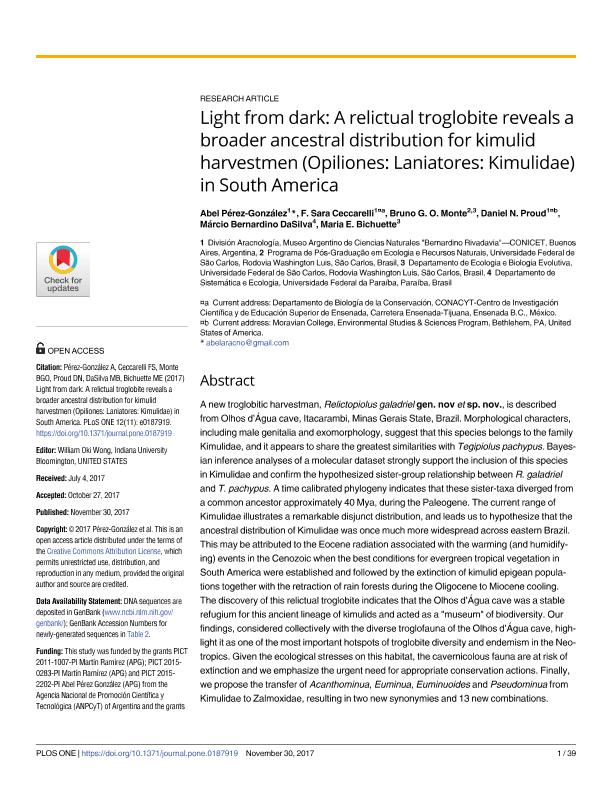Mostrar el registro sencillo del ítem
dc.contributor.author
Pérez González, Abel

dc.contributor.author
Ceccarelli, Fadia Sara

dc.contributor.author
Monte, Bruno G. O.
dc.contributor.author
Proud, Daniel Nathan

dc.contributor.author
DaSilva, Márcio Bernardino
dc.contributor.author
Bichuette, Maria E.
dc.date.available
2018-06-18T19:11:05Z
dc.date.issued
2017-11-30
dc.identifier.citation
Pérez González, Abel; Ceccarelli, Fadia Sara; Monte, Bruno G. O.; Proud, Daniel Nathan; DaSilva, Márcio Bernardino; et al.; Light from dark: a relictual troglobite reveals a broader ancestral distribution for kimulid harvestmen (Opiliones: Laniatores: Kimulidae) in South America; Public Library of Science; Plos One; 12; 11; 30-11-2017; 1-39; e0187919
dc.identifier.uri
http://hdl.handle.net/11336/49088
dc.description.abstract
A new troglobitic harvestman, Relictopiolus galadriel gen. nov et sp. nov., is described from Olhos d’Água cave, Itacarambi, Minas Gerais State, Brazil. Morphological characters, including male genitalia and exomorphology, suggest that this species belongs to the family Kimulidae, and it appears to share the greatest similarities with Tegipiolus pachypus. Bayesian inference analyses of a molecular dataset strongly support the inclusion of this species in Kimulidae and confirm the hypothesized sister-group relationship between R. galadriel and T. pachypus. A time calibrated phylogeny indicates that these sister-taxa diverged from a common ancestor approximately 40 Mya, during the Paleogene. The current range of Kimulidae illustrates a remarkable disjunct distribution, and leads us to hypothesize that the ancestral distribution of Kimulidae was once much more widespread across eastern Brazil. This may be attributed to the Eocene radiation associated with the warming (and humidifying) events in the Cenozoic when the best conditions for evergreen tropical vegetation in South America were established and followed by the extinction of kimulid epigean populations together with the retraction of rain forests during the Oligocene to Miocene cooling. The discovery of this relictual troglobite indicates that the Olhos d’Água cave was a stable refugium for this ancient lineage of kimulids and acted as a "museum" of biodiversity. Our findings, considered collectively with the diverse troglofauna of the Olhos d’Água cave, highlight it as one of the most important hotspots of troglobite diversity and endemism in the Neotropics. Given the ecological stresses on this habitat, the cavernicolous fauna are at risk of extinction and we emphasize the urgent need for appropriate conservation actions. Finally, we propose the transfer of Acanthominua, Euminua, Euminuoides and Pseudominua from Kimulidae to Zalmoxidae, resulting in two new synonymies and 13 new combinations.
dc.format
application/pdf
dc.language.iso
eng
dc.publisher
Public Library of Science

dc.rights
info:eu-repo/semantics/openAccess
dc.rights.uri
https://creativecommons.org/licenses/by/2.5/ar/
dc.subject
Caves
dc.subject
Brazil
dc.subject
Biogeography
dc.subject
Phylogenetic Analysis
dc.subject
Forests
dc.subject
Phylogenetics
dc.subject
Phylogeography
dc.subject
Genital Anatomy
dc.subject.classification
Otras Ciencias Biológicas

dc.subject.classification
Ciencias Biológicas

dc.subject.classification
CIENCIAS NATURALES Y EXACTAS

dc.title
Light from dark: a relictual troglobite reveals a broader ancestral distribution for kimulid harvestmen (Opiliones: Laniatores: Kimulidae) in South America
dc.type
info:eu-repo/semantics/article
dc.type
info:ar-repo/semantics/artículo
dc.type
info:eu-repo/semantics/publishedVersion
dc.date.updated
2018-06-04T17:17:58Z
dc.identifier.eissn
1932-6203
dc.journal.volume
12
dc.journal.number
11
dc.journal.pagination
1-39; e0187919
dc.journal.pais
Estados Unidos

dc.journal.ciudad
San Francisco
dc.description.fil
Fil: Pérez González, Abel. Consejo Nacional de Investigaciones Científicas y Técnicas. Oficina de Coordinación Administrativa Parque Centenario. Museo Argentino de Ciencias Naturales "Bernardino Rivadavia"; Argentina
dc.description.fil
Fil: Ceccarelli, Fadia Sara. Consejo Nacional de Investigaciones Científicas y Técnicas. Oficina de Coordinación Administrativa Parque Centenario. Museo Argentino de Ciencias Naturales "Bernardino Rivadavia"; Argentina
dc.description.fil
Fil: Monte, Bruno G. O.. Universidade Federal do São Carlos; Brasil
dc.description.fil
Fil: Proud, Daniel Nathan. Consejo Nacional de Investigaciones Científicas y Técnicas. Oficina de Coordinación Administrativa Parque Centenario. Museo Argentino de Ciencias Naturales "Bernardino Rivadavia"; Argentina
dc.description.fil
Fil: DaSilva, Márcio Bernardino. Universidade Federal da Paraíba; Brasil
dc.description.fil
Fil: Bichuette, Maria E.. Universidade Federal do São Carlos; Brasil
dc.journal.title
Plos One

dc.relation.alternativeid
info:eu-repo/semantics/altIdentifier/doi/https://dx.doi.org/10.1371/journal.pone.0187919
dc.relation.alternativeid
info:eu-repo/semantics/altIdentifier/url/http://journals.plos.org/plosone/article?id=10.1371/journal.pone.0187919
Archivos asociados
